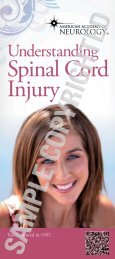Stroke - American Academy of Neurology
Stroke - American Academy of Neurology
Stroke - American Academy of Neurology
You also want an ePaper? Increase the reach of your titles
YUMPU automatically turns print PDFs into web optimized ePapers that Google loves.
Understanding<strong>Stroke</strong>Tom, experienced a stroke in 2005.
What Is <strong>Stroke</strong>?A stroke is caused by the sudden loss <strong>of</strong> blood flowto the brain or bleeding in or around the brain.Either can cause brain cells to stop functioning ordie. When nerve cells in the brain die, the function <strong>of</strong>body parts they control is harmed or lost. Dependingon the part <strong>of</strong> the brain affected, people can losespeech, feeling, muscle strength, coordination, vision,or memory. Some people recover completely; othersare seriously disabled or die.What Causes <strong>Stroke</strong>?There are two main types <strong>of</strong> stroke: hemorrhagicand ischemic. With a hemorrhagic stroke, there isbleeding in or around the brain. With an ischemicstroke, blood flow to part <strong>of</strong> the brain is blocked.Without blood flow, that part <strong>of</strong> the brain is injured.Cross Section <strong>of</strong> the BrainIschemicNarrowing ArteryBrain ArteriesBlocked Blood FlowBlood ClotHemorrhagicBloodAroundthe BrainBrain ArteriesRuptured Aneurysm
Eighty percent <strong>of</strong> strokes are ischemic. Ischemicstrokes can be caused by narrowing <strong>of</strong> the largearteries to the brain or the small arteries within thebrain. Ischemic strokes can also be caused by clots thatblock blood flow to the brain. There are many otherpossible causes <strong>of</strong> ischemic stroke. The lack <strong>of</strong> normalblood flow to brain cells sets <strong>of</strong>f a chain reaction.When blood cannot get to the brain, cells begin to diewithin minutes. Quick medical treatment is essentialto prevent the damage from spreading to a larger area<strong>of</strong> the brain where blood flow might be reduced butnot completely cut <strong>of</strong>f.Hemorrhagic strokes involve bleeding around or intothe brain. Although there are many possible causes<strong>of</strong> hemorrhagic stroke, they are most commonlycaused by:• Weak spots in brain arteries, called aneurysms,that burst and cause blood to cover the brain• Small blood vessels within the brain that breakWhat Are the Symptoms?<strong>Stroke</strong> strikes fast. You should, too. Call 9-1-1. <strong>Stroke</strong>symptoms can vary. They can start slowly or come onquickly. You may wake up with the symptoms. Actquickly if these symptoms come on SUDDENLY:• Numbness or weakness <strong>of</strong> the face, arm, or leg,especially on one side <strong>of</strong> the body• Confusion or trouble speaking or understanding• Trouble seeing in one or both eyes• Trouble walking, dizziness, or loss <strong>of</strong> balanceor coordination• Severe headacheDid you know?Neurologists are medical doctors who specializein disorders <strong>of</strong> the brain and nerves. They <strong>of</strong>tendiagnose and treat people with stroke.
Life After <strong>Stroke</strong>Although some people recover fully after a stroke, othersmay have ongoing problems. These problems depend on thesize and location <strong>of</strong> the stroke and can include:• Problems with thinking and memory• Difficulty speaking or understanding• Difficulty swallowing• Emotional problems, such as depression• Loss <strong>of</strong> vision, <strong>of</strong>ten on one side• Loss <strong>of</strong> strength or feeling on one side <strong>of</strong> the body• Loss <strong>of</strong> balance and the ability to walkRehabilitation helps regain functions lost from damage dueto stroke. During rehabilitation, most people will improve—although many do not recover completely. The brain canlearn new ways <strong>of</strong> functioning by using undamaged braincells.Preventing a Second <strong>Stroke</strong>People who have had a stroke are at much greater risk foranother stroke than those who have never had one. Talkto your neurologist about ways to prevent a second stroke.These may include medications and changes to your lifestyleincluding:• Eating a diet low in salt, fat, and cholesterol• Controlling high blood pressure• Quitting smoking• Controlling cholesterol with drugs• Taking drugs that reduce blood clottingPartnering with Your NeurologistTo provide the best care, your neurologist needs to knowall about your symptoms and medical history. Likewise,you need to get answers to your questions. Keeping anotebook about your condition and bringing a few wellorganizedquestions to your appointments can be helpful.
For Family and FriendsThe rehabilitation period after stroke is <strong>of</strong>ten achallenge for both patients and their caregivers.Recovery is supported by a multidisciplinaryteam that includes nurses and doctors. Physical,occupational, and speech therapists also play acentral role. In addition, many people find thatsupport groups are a source <strong>of</strong> help, comfort, andinformation during this time. See Resources fororganizations to contact.Help Us Cure Brain DiseaseMake a Donation to ResearchThe <strong>American</strong> Brain Foundation supports vitalresearch and education to discover causes, improvedtreatments, and cures for brain and other nervoussystem diseases. To learn more or to make a donationto support research, visit www.CureBrainDisease.org.Make Your Voice HeardTo keep research advancing toward future cures andtreatments for brain disease, it is important for peopleaffected by neurologic disorders to advocate for moreresearch funding. Contact your members <strong>of</strong> Congressand ask them to support neurology research byincreasing funding for the National Institutes <strong>of</strong> Health(NIH). Look up your Congressional representatives atwww.senate.gov and www.house.gov. Your voice canmake a difference.Take Part in ResearchPeople are needed for clinical trials that can helpfind new treatments for neurologic disorders. Clinicaltrials are research studies. They help ensure thatnew drugs are both safe and effective. Ask yourneurologist how to volunteer for a clinical trial. Youcan also find trials through patient organizations orthe <strong>American</strong> <strong>Academy</strong> <strong>of</strong> <strong>Neurology</strong> website atwww.aan.com/view/clinicaltrials.
Resources<strong>American</strong> <strong>Academy</strong> <strong>of</strong> <strong>Neurology</strong>www.aan.com(800) 879-1960The <strong>American</strong> <strong>Academy</strong> <strong>of</strong> <strong>Neurology</strong> website forpatients and caregivers <strong>of</strong>fers a wealth <strong>of</strong> articles,information about events and resources, and links tosupport groups, clinical trial information, and more.<strong>Neurology</strong> Now ® magazinewww.neurologynow.com(800) 879-1960Free magazine for patients and caregivers, courtesy <strong>of</strong>the <strong>American</strong> <strong>Academy</strong> <strong>of</strong> <strong>Neurology</strong>. Stories aboutpeople living with neurologic disorders, the latestinformation on resources and treatments, and more.<strong>American</strong> <strong>Stroke</strong> Associationwww.strokeassociation.org(888) 4STROKE (478-7653)Brain Aneurysm Foundationwww.bafound.org(888) BRAIN02 (272-4602)National Institute <strong>of</strong> Neurological Disorders and<strong>Stroke</strong>www.ninds.nih.gov(800) 352-9424National <strong>Stroke</strong> Associationwww.stroke.org(800) STROKES (787-6537)Speak Up: What you should know about strokewww.jointcommission.org/speakup.aspx
www.aan.com(800) 879-1960The <strong>American</strong> <strong>Academy</strong> <strong>of</strong> <strong>Neurology</strong>, an association <strong>of</strong>25,000 neurologists and neuroscience pr<strong>of</strong>essionals, isdedicated to promoting the highest quality patient-centeredneurologic care. For more information about the <strong>American</strong><strong>Academy</strong> <strong>of</strong> <strong>Neurology</strong>, visit www.aan.com.Cover photo by Janet Underwood









